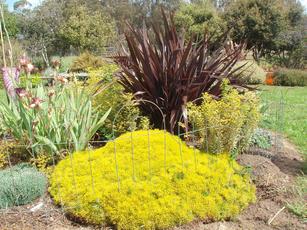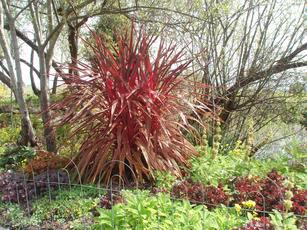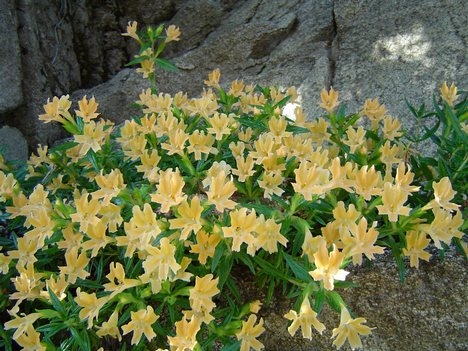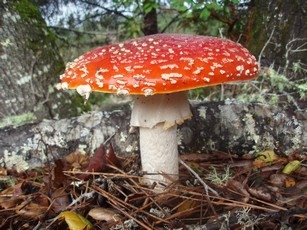 While at the Watsonville Terra Sole Nursery recently, owner's John and Sherry Hall shared with me their experiences growing and experimenting with plants in their own landscape and nursery. From these personal trials, they decide what to propagate and sell in the small, independent nursery they operate on their property.
While at the Watsonville Terra Sole Nursery recently, owner's John and Sherry Hall shared with me their experiences growing and experimenting with plants in their own landscape and nursery. From these personal trials, they decide what to propagate and sell in the small, independent nursery they operate on their property.
With a philosophy to share what they learn with their customers, they grow native and unusual plants and other drought tolerant plants that are adapted to our dry summer climate. Sherry told me that they grow their plants as sustainably as possible, hand pulling weeds and collecting snails by hand. They said they propagate and grow their plants without growth regulators or dangerous chemicals. I saw many birdbaths both in their own landscape and in the nursery. Sherry told me they encourage feathered friends like the Western Bluebird to live in the garden to eat bugs. It's a win-win situation.
Sustainable doesn't just get lip service at this nursery. They don't use labels on their containers making it easy to recycle them. And John makes his own succulent garden boxes from 100 year old barn wood. They looked awesome planted up with a collection of various succulents propagated in the greenhouse.
I commented on the hardy geraniums and other plants coming up through the gravel on the nursery floor. John and Sherry both laughed as they told me "it's the best place to propagate some of the plants. Our son works at a big grower nearby and can't propagate some of these plants even in his $10,000 greenhouse".
What were some of my favorite plants that I saw on the tour and which do they think are the best performers?
In the test garden, a Lemon Fizz santolina, with foliage so brilliant it looked like a lit light bulb, nestled at the base of a burgundy phormium. A blooming euphorbia completed the vignette. Santolinas are drought and deer tolerant. One important thing Sherry has learned from the test garden is how close to plant things. "They get a lot bigger than you'd imagine from seeing them in that cute little gallon can".
They have an extensive coral bell or heuchera collection that they have been testing for the past 4 years. Starting with 80 plants of different kinds, 90% have survived. The fancy hybrids do need some summer water and compost to look their best. The variety Pinot Gris, with molasses colored foliage, really stood out among the rest.
The echinacea were just emerging from dormancy and will bloom during the summer. They are very dependable in the garden unless the gophers get them, I was told. Agastache is another one of their favorites and the hummingbirds love them, too. They grow many colorful cordyline from clumpers to tall types. They are doing great, Sherry said. "Maybe a little too great" as they get big fast. Gaillardia have been disappointing but maybe they received too much water at the wrong time, she confessed.
In the nursery, I was drawn to the hardy geranium, 'Bill Wallace'. Loaded with purplish-blue flowers, this mounding perennial blooms for a long time. In another spot, I couldn't miss the rich, dark burgundy flowers of the camellia "Night Rider". "It's the only camellia we grow", the Hall's explained. A very slow grower, it's perfect for containers.
At the Spring Trials they bought a flat of a new acacia called 'Cousin Itt'. This plant is very different from the invasive tree we see blooming each winter. A well behaved 30" mound of soft, emerald green foliage it's drought tolerant and would look great near a dry stream bed.
With so many plants to talk about, we ran out of time and ended with the "under-used, under-appreciated" Beschorneria. This genus of succulent plants belong to the subfamily agavoides and is native to Mexico. The Hall's are concentrating on propagating a variegated variety in their nursery. A tall blooming red spike had emerged from one of the green species.
This is just a taste of the many plants I learned about that day at Terra Sole Nurseries. From drought tolerance, disease resistance, cold and wildlife compatible the experiments continue.
You can find out more about this small nursery at www.terrasolenurseries.com.


 our garden. Some, like ceanothus, have already been cultivated for a century or more, both here and abroad.
our garden. Some, like ceanothus, have already been cultivated for a century or more, both here and abroad.
.jpg) over the soil by The Boy Scouts to preserve the structure and prevent it from packing down again.
over the soil by The Boy Scouts to preserve the structure and prevent it from packing down again..jpg) color ranges from reddish purple, brilliant red to golden orange. Crabapples are good lawn trees and their spring blossoms are stunning. To avoid disfiguring diseases, choose varieties that are resistant to cedar-apple rust, scab and powdery mildew. Among these is ‘Prairiefire‘, with pink flowers and dark red fruit. This tree grows 20 feet tall.
color ranges from reddish purple, brilliant red to golden orange. Crabapples are good lawn trees and their spring blossoms are stunning. To avoid disfiguring diseases, choose varieties that are resistant to cedar-apple rust, scab and powdery mildew. Among these is ‘Prairiefire‘, with pink flowers and dark red fruit. This tree grows 20 feet tall.